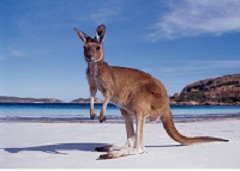Imagine Easter and Labor Day both falling on the same four day weekend, with fall and winter soon to follow. Then, add a populace that loves to be outdoors, whether camping, tramping, fishing, kayaking, or just messing around in boats. Finally, picture only a few roads out of the largest city in the country, all headed towards idyllic coasts and forests. That's New Zealand this weekend. We began to see the exodus after dark on Thursday while we were eating mussels along the main road into Coromandel. It was a nearly non-stop stream of traffic, every fourth or fifth towing a boat on a trailer or carrying kayaks on the roof.
Then, Friday morning, as we headed out of the peninsula we were confronted by a continuous stream of traffic on the narrow, winding roads along the coast, fortunately almost all of it headed in the opposite direction. It was hard to imagine that that many people even lived in the country!
 |
| A last look at the Coromandel Peninsula coastline |
 |
Every parking lot near a boat ramp was crowded with vehicles attached
to empty boat trailers ... |
 |
... and every bache, motel, B&B, and holiday park occupied. We'd not seen
such crowds of native travelers anywhere in our seven months away from
home, and when the weekend is over that will probably be it. |
 |
We stopped at a beach along the way and saw large flocks of Pied
Oystercatchers ... |
 |
... which isn't too surprising since this is one of the world's great shellfish
growing areas. |
As we drove north through greater Auckland the traffic coming out of the city had reached a standstill, always such a jolly way to start a vacation. And we started seeing clouds, which turned to rain once we were north of the city. We stopped for a few groceries in a small town north of Auckland, then checked into a rather decrepit campground where we were charged $40 to spend the night, the most we've paid in NZ. Oh well, we had a place to stay, which after looking earlier into a completely full large public campground, seemed a relief. That, and finally being off the busy roads. To tell you the truth, if we'd known this weekend would see such a deluge of Kiwis hitting the road, we probably would have planned to come home sooner. Oh well, it's only two weeks until we leave.




















































